Are The Rumors About The Ozone Layer Being Totally Fixed True ? If Yes , Is It Susceptible Of Being Opened
Are the rumors about the ozone layer being totally fixed true ? If yes , is it susceptible of being opened again ans if no, is it suspecte
More Posts from Nasa and Others
Flooding Along the Mississippi
Rain, snowmelt, and soil moisture—those three factors might push portions of the Upper Mississippi River into major flooding this spring. Meanwhile, the middle and lower reaches of the river are already well out of their banks.
Intense storms over February 22-24, 2019, caused major flooding along the Middle Mississippi River. On February 25, 2019, the Landsat 8 satellite acquired images of swollen portions of the Mississippi River. The video above shows a false-color view of flooding near Memphis, Tennessee comparing February 2019 to February 2014. Flood waters appear blue; vegetation is green; and bare ground is brown. Notice how the Ohio River and Mississippi River have swelled near Cairo, the southernmost city in Illinois.
National Weather Service forecasters noted that higher-than-average precipitation in autumn 2018 saturated soils in the region, so additional rain or snowmelt from this winter will likely result in excessive runoff and increased flooding threats.
Rapid snowmelt will also play a role in flooding this spring in the Midwest. Parts of Minnesota and Wisconsin have built up snowpack of nearly 25 inches, so melting snow alone could propel many areas into major flooding.
Read the full story here.
Make sure to follow us on Tumblr for your regular dose of space: http://nasa.tumblr.com
Join NPR today at 5 p.m. EDT for #NPRSpaceJam with astronauts Serena Auñón, Cady Coleman, Samantha Cristoforetti, plus our chief scientist Ellen Stofan. Submit your questions!

Tomorrow at 5ET I’ll be interviewing three astronauts (read all about them here) live on Periscope and Snapchat (user: nprnews).
What would you like me to ask them? Submit questions here.
Get Ready Stargazers: The Geminids Are Here!
The Geminid meteor shower, one of the biggest meteor showers of the year, will peak this weekend, December 13 to 14. We get a lot of questions about the Geminids—so we’ve put together some answers to the ones we’re most commonly asked. Take a look!
What are the Geminids?
The Geminids are pieces of debris from an asteroid called 3200 Phaethon. Earth runs into Phaethon’s debris stream every year in mid-December, causing meteors to fly from the direction of the constellation Gemini – hence the name “Geminids.”

Image Credit: Arecibo Observatory/NASA/NSF
When is the best time to view them?
This year, the peak is during the overnight hours of December 13 and into the morning of December 14. Viewing should still be good on the night of December 14 into the early morning hours of the 15th. Weather permitting, the Geminids can be viewed from around midnight to 4 a.m. local time. The best time to see them is around 2 a.m. your local time on December 14, when the Geminid radiant is highest in your night sky. The higher the radiant – the celestial point in the sky from which meteors appear to originate – rises into the sky, the more meteors you are likely to see.

Image Credit & Copyright: Jeff Dai
What is the best way to see them?
Find the darkest place you can and give your eyes about 30 minutes to adapt to the dark. Avoid looking at your cell phone, as it will disrupt your night vision. Lie flat on your back and look straight up, taking in as much sky as possible. You will soon start to see the Geminid meteors!

Image Credit: NASA/Bill Dunford
Can you see the Geminids from anywhere in the world?
The Geminids are best observed in the Northern Hemisphere, but no matter where you are in the world (except Antarctica), some Geminids will be visible.

Image Credit: Jimmy Westlake
How many Geminids can I expect to see?
Under dark, clear skies, the Geminids can produce up to 120 meteors per hour – but this year, a bright, nearly full moon will hinder observations of the shower. Still, observers can hope to see up to 30 meteors per hour. Happy viewing!

Image Credit & Copyright: Yuri Beletsky
Make sure to follow us on Tumblr for your regular dose of space: http://nasa.tumblr.com
Which is scarier? Launch VS re-entry?
Warm yourself by the fire, NASA style!
Look no further than this cozy and relaxing fireplace – complete with four RS-25 rocket engines to fill your hearth with light. (And 8.8 million pounds of thrust to power your party to the Moon.)
Space Gardening 101
You can’t escape eating (or gardening!) your vegetables, even if you’re in space. On Aug. 10, astronauts on the International Space Station sampled their first space grown salad. This freshly harvest red romaine lettuce was grown in the “Veggie” plant growth chamber that is designed to make gardens flourish in weightlessness.
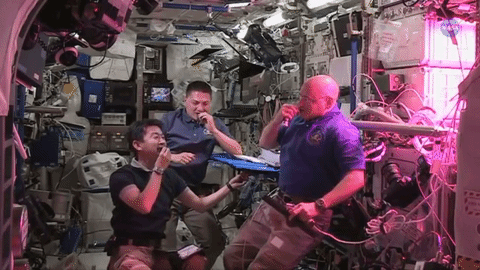
In a weightless environment, there is no up and down, so roots grow in all directions. Water and soil, the materials used to anchor these plants and allow for root growth tend to float away.
How Do We Grow Plants in Space?
1. Plant Pillows
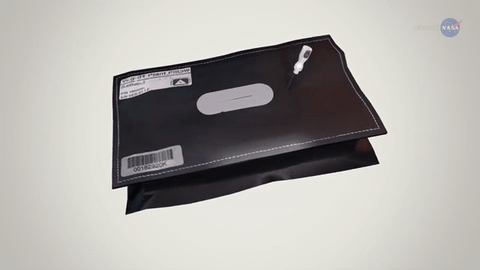
The Veggie chamber helps solve the problems of a weightless environment by using ‘plant pillows’, sounds comfy right? These pillows are bags filled with material for growing plants in space.
2. Wicks

Wicks are implanted into the bags and are used to draw water from inside the pillow to the plant.
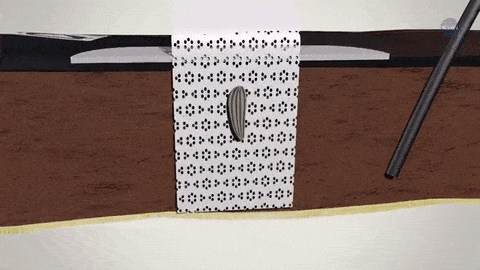
These wicks also provide a place to glue the seeds. It’s important to orient the seeds so roots will grow ‘down’, and shoots that emerge will push out of the bag.
3. LED Lights
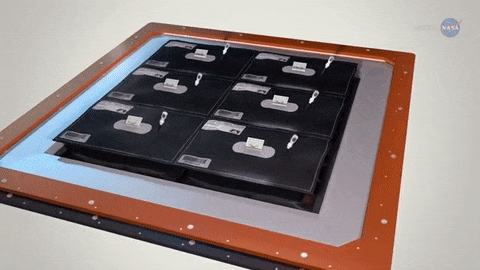
LED lights are used for photosynthesis and give the shoots a sense of direction so they keep growing upward. The walls of the Veggie chamber can expand to make room for the plant as it grows.
The purple/pinkish hue surrounding the plants in Veggie is the result of a combination of the red and blue lights, which is what the plants need to grow. Green LEDS were added so the plants look like edible food rather than weird purple plants.
Why are we growing plants in space?
When astronauts travel on deep space missions, like Mars, they will need to be self-sufficient for long periods of time. Having the ability to grow their own food is a big step in that direction. There is also a desire to grow flowering vegetables in space, which is why we are currently tending to zinnia flowers on orbit. Growing these flowering plants will help us understand longer duration growing plants that have to flower in space, such as tomatoes.
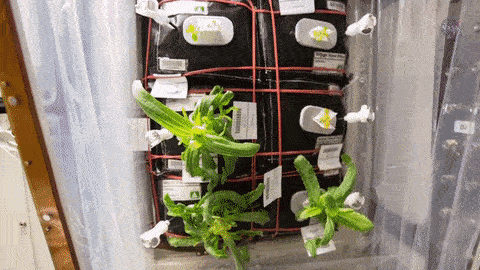
What’s Next? The next SpaceX delivery will include seeds for a small cabbage and additional red romaine lettuce. Upcoming experiments will use various ratios of red and blue lights and different fertilizers in attempts to improve crop yield, nutrition and flavor. The findings from these experiments can be utilized both on Earth and in space.
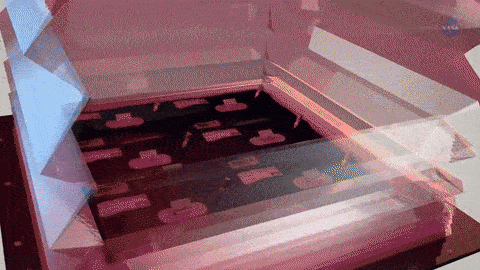
In addition to the nutrition benefits of growing vegetables in space, the psychological benefits are also significant. Having living plants can help with stress and increase the crews’ enjoyment. It provides the sights, smells and tastes of Earth.
To learn more about gardening in space, watch ScienceCast HERE.
Make sure to follow us on Tumblr for your regular dose of space: http://nasa.tumblr.com
Was There Once Life On Mars? Our Perseverance Rover Aims to Find Out
Our Perseverance mission is set to launch on Thursday, July 30 and could help answer many longstanding astrobiology questions about Mars. The mission will deliver our Perseverance rover to the Martian surface, and this powerful rover is equipped with a multitude of tools to study the planet's environment and to answer questions about whether or not the Red Planet could have had life in the past.

In preparation for launch, our Astrobiology Program is releasing a new update to Issue #2 of the graphic history series, Astrobiology: The Story of our Search for Life in the Universe. This new, fourth edition tells the tale of our exploration of Mars in relation to astrobiology.

The history of our exploration of Mars is full of struggle and triumph. Mars is a dangerous and difficult planet to visit, with frigid temperatures, damaging dust storms, low gravity, and a thin atmosphere. Despite the challenges, NASA missions have opened our eyes to a world that was much more Earth-like in its past, with environments that contained all the necessary conditions for life as we know it.

Issue #2 tells the complete history of our endeavours on Mars, from the Mariner missions to Viking and Pathfinder to Curiosity. In this fourth edition, you’ll find details on the Perseverance rover and its journey to search for ancient signs and signatures of life that could once and for all tell us whether or not life gained a foothold on the ancient Red Planet.

Perseverance will also drill into Martian rocks and collect samples that will one day be returned to Earth by a future Mars Sample Return mission. The samples will be stored in special containers and carefully 'cached' in a location on Mars where they will be easily accessible for retrieval. These samples will allow astrobiologists to perform detailed experiments that robots are not yet able to undertake remotely.

Visit astrobiology.nasa.gov/graphic-histories/ to download the new edition of Astrobiology: The Story of our Search for Life in the Universe, and read the entire series to explore NASA’s astrobiology journey to understand the origin and evolution of life on Earth, and the potential for life elsewhere in the Universe!
Make sure to follow us on Tumblr for your regular dose of space: http://nasa.tumblr.com
Celebrating Women’s History Month: Most Recent Female Astronauts
For Women’s History Month, NASA and the International Space Station celebrate the women who conduct science aboard the orbiting lab. As of March 2019, 63 women have flown in space, including cosmonauts, astronauts, payload specialists, and space station participants. The first woman in space was Russian cosmonaut Valentina Tereshkova who flew on Vostok 6 on June 16, 1963. The first American woman in space, Sally Ride, flew aboard the Space Shuttle STS-7 in June of 1983.
If conducted as planned, the upcoming March 29 spacewalk with Anne McClain and Christina Koch would be the first all-female spacewalk. Women have participated in science on the space station since 2001; here are the most recent and some highlights from their scientific work:
Christina Koch, Expedition 59

Christina Koch (pictured on the right) becomes the most recent woman in space, launching to the space station in mid-March to take part in some 250 research investigations and technology demonstrations. Koch served as station chief of the American Samoa Observatory and has contributed to the development of instruments used to study radiation particles for the Juno mission and the Van Allen Probe.
Anne McClain, Expedition 57/58, 59

Flight Engineer Anne McClain collects samples for Marrow, a long-term investigation into the negative effects of microgravity on the bone marrow and blood cells it produces. The investigation may lead to development of strategies to help prevent these effects in future space explorers, as well as people on Earth who experience prolonged bed rest. McClain holds the rank of Lieutenant Colonel as an Army Aviator, with more than 2,000 flight hours in 20 different aircraft.
Serena M. Auñón-Chancellor, Expedition 56/57

Serena Auñón-Chancellor conducts research operations for the AngieX Cancer Therapy inside the Microgravity Science Glovebox (MSG). This research may facilitate a cost-effective drug testing method and help develop safer and more effective vascular-targeted treatments. As a NASA Flight Surgeon, Auñón-Chancellor spent more than nine months in Russia supporting medical operations for International Space Station crew members.
Peggy Whitson, Expeditions 5, 16, 50, 51/52

Astronaut Peggy Whitson holds numerous spaceflight records, including the U.S. record for cumulative time in space – 665 days – and the longest time for a woman in space during a single mission, 289 days. She has tied the record for the most spacewalks for any U.S. astronaut and holds the record for the most spacewalk time for female space travelers. She also served as the first science officer aboard the space station and the first woman to be station commander on two different missions. During her time on Earth, she also is the only woman to serve as chief of the astronaut office. Here she works on the Genes in Space-3 experiment, which completed the first-ever sample-to-sequence process entirely aboard the International Space Station. This innovation makes it possible to identify microbes in real time without having to send samples back to Earth, a revolutionary step for microbiology and space exploration.
Kate Rubins, Expedition 48/49

The Heart Cells investigation studies the human heart, specifically how heart muscle tissue contracts, grows and changes its gene expression in microgravity and how those changes vary between subjects. In this image, NASA astronaut Kate Rubins conducts experiment operations in the U.S. National Laboratory. Rubins also successfully sequenced DNA in microgravity for the first time as part of the Biomolecule Sequencer experiment.
Samantha Cristoforetti, Expedition 42/43

The first Italian woman in space, European Space Agency (ESA) astronaut Samantha Cristoforetti conducts the SPHERES-Vertigo investigation in the Japanese Experiment Module (JEM). The investigation uses free-flying satellites to demonstrate and test technologies for visual inspection and navigation in a complex environment.
Elena Serova, Expedition 41/42

Cosmonaut Elena Serova, the first Russian woman to visit the space station, works with the bioscience experiment ASEPTIC in the Russian Glavboks (Glovebox). The investigation assessed the reliability and efficiency of methods and equipment for assuring aseptic or sterile conditions for biological investigations performed on the space station.
Karen Nyberg, Expedition 36/37

NASA astronaut Karen Nyberg sets up the Multi-Purpose Small Payload Rack (MSPR) fluorescence microscope in the space station’s Kibo laboratory. The MSPR has two workspaces and a table used for a wide variety of microgravity science investigations and educational activities.
Sunita Williams, Expeditions 32/33, 14/15

This spacewalk by NASA astronaut Sunita Williams and Japan Aerospace Exploration Agency (JAXA) astronaut Aki Hoshide, reflected in Williams’ helmet visor, lasted six hours and 28 minutes. They completed installation of a main bus switching unit (MBSU) and installed a camera on the International Space Station’s robotic Canadarm2. Williams participated in seven spacewalks and was the second woman ever to be commander of the space station. She also is the only person ever to have run a marathon while in space. She flew in both the space shuttle and Soyuz, and her next assignment is to fly a new spacecraft: the Boeing CST-100 Starliner during its first operational mission for NASA’s Commercial Crew Program.
Cady Coleman, Expeditions 26/27

Working on the Capillary Flow Experiment (CFE), NASA astronaut Catherine (Cady) Coleman performs a Corner Flow 2 (ICF-2) test. CFE observes the flow of fluid in microgravity, in particular capillary or wicking behavior. As a participant in physiological and equipment studies for the Armstrong Aeromedical Laboratory, she set several endurance and tolerance records. Coleman logged more than 4,330 total hours in space aboard the Space Shuttle Columbia and the space station.
Tracy Caldwell Dyson, Expedition 24

A system to purify water for use in intravenous administration of saline would make it possible to better treat ill or injured crew members on future long-duration space missions. The IVGEN investigation demonstrates hardware to provide that capability. Tracy Caldwell Dyson sets up the experiment hardware in the station’s Microgravity Science Glovebox (MSG). As noted above, she and Shannon Walker were part of the first space station crew with more than one woman.
Shannon Walker, Expedition 24/25

Astronaut Shannon Walker flew on Expedition 24/25, a long-duration mission that lasted 163 days. Here she works at the Cell Biology Experiment Facility (CBEF), an incubator with an artificial gravity generator used in various life science experiments, such as cultivating cells and plants on the space station. She began working in the space station program in the area of robotics integration, worked on avionics integration and on-orbit integrated problem-solving for the space station in Russia, and served as deputy and then acting manager of the On-Orbit Engineering Office at NASA prior to selection as an astronaut candidate.
Stephanie Wilson, STS-120, STS-121, STS-131

Astronaut Stephanie Wilson unpacks a Microgravity Experiment Research Locker Incubator II (MERLIN) in the Japanese Experiment Module (JEM). Part of the Cold Stowage Fleet of hardware, MERLIN provides a thermally controlled environment for scientific experiments and cold stowage for transporting samples to and from the space station. Currently serving as branch chief for crew mission support in the Astronaut Office, Wilson logged more than 42 days in space on three missions on the space shuttle, part of the Space Transportation System (STS).
Other notable firsts:
• Roscosmos cosmonaut Svetlana Savitskaya, the first woman to participate in an extra-vehicular activity (EVA), or spacewalk, on July 25, 1984
• NASA astronaut Susan Helms, the first female crew member aboard the space station, a member of Expedition 2 from March to August 2001
• NASA astronaut Peggy Whitson, the first female ISS Commander, April 2008, during a six-month tour of duty on Expedition 16
• The most women in space at one time (four) happened in 2010, when space shuttle Discovery visited the space station for the STS-131 mission. Discovery’s crew of seven included NASA astronauts Dorothy Metcalf-Lindenburger and Stephanie Wilson and Japan Aerospace Exploration Agency (JAXA) astronaut Naoko Yamazaki. The space station crew of six included NASA astronaut Tracy Caldwell Dyson.
• Susan Helms shares the record for longest single spacewalk, totaling 8 hours 56 minutes with fellow NASA astronaut Jim Voss.
• Expedition 24 marked the first with two women, NASA astronauts Shannon Walker and Tracy Caldwell Dyson, assigned to a space station mission from April to September, 2010
• The 2013 astronaut class is the first with equal numbers of women and men.
• NASA astronaut Anne McClain became the first woman to live aboard the space station as part of two different crews with other women: Serena Auñón-Chancellor in December 2018 and currently in orbit with Christina Koch.
Make sure to follow us on Tumblr for your regular dose of space: http://nasa.tumblr.com
Here’s What You Need to Know About Near-Earth Objects
Our solar system is littered with asteroids and comets, and sometimes they get a little close to Earth. But no need to worry! This happens all the time. When an asteroid or comet could come close to our planet, it’s known as a near-Earth object – aka NEO.
But how close is “close”?

A near-Earth object is defined as an object that could pass by our Earth within 30 million miles. We begin to keep close watch on objects that could pass within 5 million miles of our planet.

To put that into perspective, our Moon is only 238,900 miles away.
However unlikely an impact is, we want to know about all near-Earth objects. Our Planetary Defense Coordination Office maintains watch for asteroids and comets coming close to Earth. Along with our partners, we discover, catalog and characterize these bodies.

But what if one of these objects posed a threat?
We want to be prepared. That is why we are working on several deflection techniques and technologies to help protect our planet.

So next time that you hear of an asteroid passing “close” to Earth, know that it’s just one of many that we are tracking.

Here are 10 more things you should know about Planetary Defense.
Make sure to follow us on Tumblr for your regular dose of space: http://nasa.tumblr.com

Ever want to ask a real life astronaut a question? Here’s your chance!
We are kicking off Hispanic Heritage Month a little early this year, and astronaut Serena M. Auñón-Chancellor will be taking your questions in an Answer Time session on Thursday, September 12 from 12pm - 1pm ET here on NASA’s Tumblr! Find out what it’s like to be a NASA astronaut and learn more about her Cuban-American heritage. Make sure to ask your question now by visiting http://nasa.tumblr.com/ask!
Dr. Serena M. Auñón-Chancellor began working with NASA as a Flight Surgeon in 2006 and was later selected as a NASA astronaut in 2009. Her first flight was from Jun 6- Dec. 20, 2018 where she served as Flight Engineer on the International Space Station as a member of Expeditions 56 and 57. During these missions, the crew contributed to hundreds of experiments in biology, biotechnology, physical science and Earth science – including investigations into a new cancer treatment!
She has a Bachelor of Science in Electrical Engineering from The George Washington University, Washington, D.C and a Doctorate of Medicine from The University of Texas - Health Science Center at Houston.
Dr. Auñón-Chancellor Fun Facts:
She spent 2 months in Antarctica from 2010 to 2011 searching for meteorites as part of the ANSMET expedition.
She served as an Aquanaut on the NEEMO 20 mission in the Aquarius underwater laboratory, which is used to prepare for living and working in space.
She logged 197 days in space during Expeditions 56 and 57.
Follow Serena on Twitter at @AstroSerena and follow NASA on Tumblr for your regular dose of space.
-
 watch reblogged this · 1 year ago
watch reblogged this · 1 year ago -
 ap93099782 liked this · 4 years ago
ap93099782 liked this · 4 years ago -
 hopeful123 liked this · 4 years ago
hopeful123 liked this · 4 years ago -
 annoyingranchsoulland liked this · 4 years ago
annoyingranchsoulland liked this · 4 years ago -
 getonmybookshelf liked this · 4 years ago
getonmybookshelf liked this · 4 years ago -
 mongoboogie liked this · 4 years ago
mongoboogie liked this · 4 years ago -
 theeyeballwoman liked this · 4 years ago
theeyeballwoman liked this · 4 years ago -
 theartanarchist liked this · 4 years ago
theartanarchist liked this · 4 years ago -
 perpetualnoise reblogged this · 4 years ago
perpetualnoise reblogged this · 4 years ago -
 perpetualnoise liked this · 4 years ago
perpetualnoise liked this · 4 years ago -
 androgynousscissorspsychicbear liked this · 4 years ago
androgynousscissorspsychicbear liked this · 4 years ago -
 wowlookbees liked this · 4 years ago
wowlookbees liked this · 4 years ago -
 vickyhantari liked this · 4 years ago
vickyhantari liked this · 4 years ago -
 yusufyucee-blog liked this · 4 years ago
yusufyucee-blog liked this · 4 years ago -
 anelva liked this · 4 years ago
anelva liked this · 4 years ago -
 noodle0180 liked this · 4 years ago
noodle0180 liked this · 4 years ago -
 roket107 liked this · 4 years ago
roket107 liked this · 4 years ago -
 yasseressam2 liked this · 4 years ago
yasseressam2 liked this · 4 years ago -
 booksandpears liked this · 4 years ago
booksandpears liked this · 4 years ago -
 1e4tfss liked this · 4 years ago
1e4tfss liked this · 4 years ago -
 eleanorlonely liked this · 4 years ago
eleanorlonely liked this · 4 years ago -
 rahvona-blog liked this · 4 years ago
rahvona-blog liked this · 4 years ago -
 simplehourss reblogged this · 4 years ago
simplehourss reblogged this · 4 years ago -
 simplehourss liked this · 4 years ago
simplehourss liked this · 4 years ago -
 princeofnigeria1 liked this · 4 years ago
princeofnigeria1 liked this · 4 years ago -
 lemkaz liked this · 4 years ago
lemkaz liked this · 4 years ago -
 gentlemancolcappello liked this · 4 years ago
gentlemancolcappello liked this · 4 years ago -
 golilly13universe liked this · 4 years ago
golilly13universe liked this · 4 years ago -
 rulandtafego liked this · 4 years ago
rulandtafego liked this · 4 years ago -
 ailaven liked this · 4 years ago
ailaven liked this · 4 years ago -
 marvel-smut liked this · 4 years ago
marvel-smut liked this · 4 years ago -
 akshayk liked this · 4 years ago
akshayk liked this · 4 years ago -
 theanniewisegirl liked this · 4 years ago
theanniewisegirl liked this · 4 years ago -
 beautifullymelancholy reblogged this · 4 years ago
beautifullymelancholy reblogged this · 4 years ago -
 beautifullymelancholy liked this · 4 years ago
beautifullymelancholy liked this · 4 years ago -
 too-much-to-read liked this · 4 years ago
too-much-to-read liked this · 4 years ago -
 scintillatingramblings liked this · 4 years ago
scintillatingramblings liked this · 4 years ago -
 luna137lovegood liked this · 4 years ago
luna137lovegood liked this · 4 years ago
Explore the universe and discover our home planet with the official NASA Tumblr account
1K posts